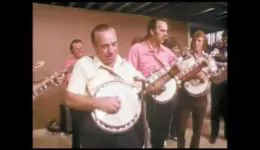Massive Herd of Elk in Montana
This video shows a huge heard crossing the road near Yellowstone. It’s located at Bozeman, MT. We have never seen such a big herd before. Poor little guy at the end. Luckily he finally caught up. What did you think of the elk crossing?
Elk migration in Yellowstone National Park is a fascinating natural phenomenon. Here are some interesting facts about it:
- Seasonal Movement: Elk in Yellowstone undertake one of the longest remaining land mammal migrations in the contiguous United States. They migrate between their winter range in the northern parts of the park and their summer range in the higher elevations of the park.
- Population Size: The northern Yellowstone elk herd is one of the largest herds in North America, with an estimated population of around 10,000 individuals.
- Altitudinal Migration: Elk undertake altitudinal migration, moving from lower elevation winter ranges to higher elevation summer ranges. During winter, they descend to lower valleys where they find milder temperatures and access to food.
- Breeding Season: Elk migration in Yellowstone is influenced by the breeding season, known as the rut, which typically occurs in the fall. During this time, the bulls compete for mating rights by bugling, displaying their antlers, and engaging in physical confrontations.
- Route Selection: The migration routes of elk in Yellowstone are not fixed and can vary from year to year. The selection of routes depends on factors such as snow depth, forage availability, and predator avoidance.
- Natural Barriers: Elk migration routes are sometimes impeded by natural barriers like deep snow or large rivers. These obstacles can influence the timing and success of migration, as elk need to find suitable crossing points.
- Predator-Prey Interaction: The migration of elk in Yellowstone also influences predator behavior. Wolves, Yellowstone’s apex predators, are known to follow the elk herds during migration, targeting weak or injured individuals.
- Ecological Impact: Elk migration plays a vital role in shaping the landscape and maintaining ecological balance in Yellowstone. Their grazing patterns can affect plant growth, and their movements help disperse seeds and nutrients.
- Human-Wildlife Interactions: Elk migration attracts a significant number of visitors to Yellowstone, providing them with opportunities to observe and appreciate this natural spectacle. Park authorities manage traffic and access points to minimize disturbances to the migrating elk.
- Research and Conservation: Scientists study elk migration in Yellowstone to understand the ecological processes and inform conservation efforts. Research helps in evaluating the impacts of climate change, habitat alteration, and human activities on elk populations and their migration patterns.
These fascinating elk migrations in Yellowstone National Park showcase the intricate relationship between wildlife, landscape, and the dynamic processes of nature.
Please let us know in the comment section below and remember to share the video and sign up for our free newsletter!





September 20, 2014 @ 4:37 pm
Great video. Thanks for sharing!
September 20, 2014 @ 4:35 pm
Who cares what male Elk are called. Obviously those who name-call and argue do care. Nice to see that sand-boxes are alive and well and busy. hahaha
September 19, 2014 @ 7:09 pm
Last winter I was traveling north of Missoula, MT and there was a wildlife overpass over the highway. So some places do have them. I think they’re a great idea.
September 20, 2014 @ 4:49 pm
Reba, You should have stopped by for coffee. That is just a few miles up the road from me, on the Reservation. It keeps animals and people safe.
September 22, 2014 @ 10:52 am
Dennis, thanks, would have loved a cup of coffee right about then. We were on our way back from (can’t remember the name of the town now, but it was up past Whitefish.) We had been dogsledding. I enjoy Montana so much when I visit there, there is so much beauty.
September 19, 2014 @ 6:33 pm
I agree with the over/underpass solution. I don’t agree with Don Schimpff’s last sentence; let’s be kind to BOTH animals and humans, since we are partners on this planet. Threats of violence do not resolve anything except to polarize us. Let’s be the best that humans can be, not the worst.
September 19, 2014 @ 6:31 pm
The word STAG is most often meant to apply to the European Red deer. (Or you guys who can’t get a date but like to dance with each other.)
October 14, 2014 @ 7:10 pm
In MAINE WHERE i MI GRATED FROM THE MALE DEER ARE CALLED A STAG FEMALE A DOE
September 19, 2014 @ 6:27 pm
Sad about the last elk getting pierced so many times by the damn barbed wire. The solution is very simple: Build an underpass under the road, or an overpass. Colorado has underpasses for wildlife to help them migrate easily. For Elk, an underpass (or overpass) should be an absolute Must . [If you have a problem with this, I’d enjoy giving you a barbwire overcoat.]
September 17, 2014 @ 1:44 pm
Priceless.
September 16, 2014 @ 3:30 pm
Grew up in The Big Sky Country and do miss it–now in Arizona. Drove by this area in the past but never saw the heard. My son and I did see a huge heard of antelope-about the same size- just north of Cody, Wyoming near the southeast entrance to the park on one of those Father/Son trips. He was only eight and had never seen anything like it. Great experience for both of us.
September 14, 2014 @ 11:13 pm
You are somewhat of a dumb shit, Detlef. A stag is the male of elk, deer and other antlered species. What are they called if not elk? You should get out of your house more, there is a whole big world out there.
September 19, 2014 @ 8:02 pm
A male Elk is called a BULL not a Stag, you are the dumb shit!
September 14, 2014 @ 1:43 pm
There are no elks, but stags!!!!
September 20, 2014 @ 4:31 pm
Detlef, the others are right!